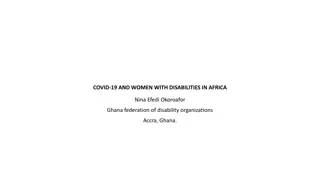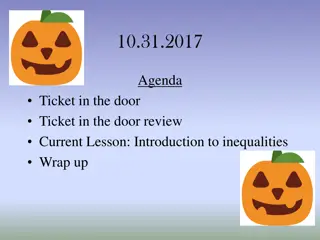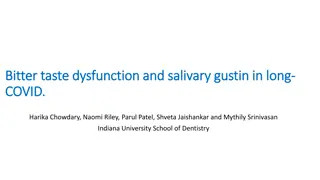Addressing Educational Inequalities Exacerbated by COVID-19
COVID-19 has intensified educational disparities, widening the gap in verbal ability scores between different socioeconomic groups. School closures have shifted learning to homes, posing challenges such as lack of resources in lower-income households and time constraints due to essential work. Strategies are needed to support students facing these obstacles.
Download Presentation

Please find below an Image/Link to download the presentation.
The content on the website is provided AS IS for your information and personal use only. It may not be sold, licensed, or shared on other websites without obtaining consent from the author. Download presentation by click this link. If you encounter any issues during the download, it is possible that the publisher has removed the file from their server.
E N D
Presentation Transcript
Irelands COVID19 Crisis Response: Perspectives from Social Science PANEL 1B COVID-19: Exacerbating Educational Inequalities? Dr. Orla Doyle Associate Professor, UCD School of Economics & Geary Institute for Public Policy, Director of the UCD Childhood and Human Development (CHilD) Research Centre
School Closures & Covid School Closures & Covid- -19 19 12thMarch 2020 - closure of all preschools, schools, and higher education institutions School closure is a non-pharmaceutical measure used to mitigate the transmission of viruses Potential consequence of school closures is a widening of inequalities in education and skills
Socioeconomic (SES) Inequalities in Socioeconomic (SES) Inequalities in Education Education By age 3, a 15-point gap in the verbal ability scores by SES, and by age 13, the gap widens to 30-points (Quigley and Nixon, 2016) Inequalities may be attributed to the Family Investment Model (Bradley and Corwyn, 2002) and/or the Family Stress Model (Conger et al. 1994) Disadvantaged families face financial constraints, poorer parental education, and higher stress Parents from such backgrounds often spend less time investing in their children s education (Del Bono et al., 2016), they provide less stimulating learning materials and learning experiences to their children (Miller et al., 2014), and they often engage in more permissive or harsh parenting (Bradley and Corwyn, 2002) Schools can reduce the magnitude of the gap
Schooling during COVID Schooling during COVID- -19 19 As a result of COVID-19, school closures have shifted education from the classroom to the home Home schooling is now a reality for the close to 1 million children who are currently enrolled in primary and secondary schools (CSO, 2020) Virtual/remote supports made available DES website, school s websites, educational apps, virtual classes, resources from teachers, text messaging and email, RTE Home School Hub Likely to be a high level of variability in both schools and parents capacity to provide and effectively use these resources
Issues with home schooling during COVID Issues with home schooling during COVID- -19 19 Home Schooling may be more challenging in lower SES households Lack the physical resources (e.g. overcrowding, desk space, computers, wifi) Time constraints (e.g. working in essential services) Literacy issues Heightened stress Health problems
on 6th thApril Survey conducted by Survey conducted by Amarach Amarachon 6 April Figure 1: % Time Spent Per Day Home Schooling Children by Parent's Educational Level 60% 53% 52% 50% 40% 30% 26% 22% 19% 20% 17% 10% 4% 4% 2% 0% 0% <30 mins 1-2 hrs 3-4 hrs 4-5 hrs >6 hrs High Education Low Education
on 6th thApril Survey conducted by Survey conducted by Amarach Amarachon 6 April Figure 2: Use and Availability of Educational Resources by Parent's Educational Level 53% Resources sent by teacher 62% 30% RTE's Home School Hub 46% 24% Virtual classes with teacher 28% 28% Apps e.g. Edmodo/Aladdin 39% 81% Texts/emails from school 76% 53% School website 56% 19% Dept. of Education website 23% 0% 10% 20% 30% 40% 50% 60% 70% 80% 90% Low Education High Education
Long term implications of school closures Long term implications of school closures Heaton (2008) studies the impact of school closures due to opposition to court- mandated integration of African-American and white children Children in the affected county did not experience poorer financial, health or criminal outcomes later in life Goodman (2014) studies unexpected school absences and closures due to bad weather i.e. snow days Each individual student absence reduces math achievement by 0.05 standard deviations, however school closures due to snow days had no impact on children s test scores Lavy (2015) investigates the impact of differences in the number of hours of instructional time across countries A one-hour increase per week of instruction in core subjects increases test scores by 0.06 of a standard deviation & effects are even larger for children from lower SES backgrounds
Implications Implications Lower SES children particularly as risk of summer drift , i.e. decline in academic skills experienced during the summer break (Alexander et al., 2007; Cooper et al., 1996) Some evidence to suggest that lower SES children may be particularly impacted by the current school closures Adopt concept of proportionate universalism : families receive some level of support, but families with higher levels of need receive more support
Possible Solutions Possible Solutions Deliver educational materials with School Meals Programme food parcels Teacher guided video calls for at risk children School helpline during school hours Special Needs Assistants continue working with children/support parents Opening schools on a very limited basis for the most vulnerable children Text message reminders & tips (e.g. Mayer et al. 2019; York et al. 2019)























